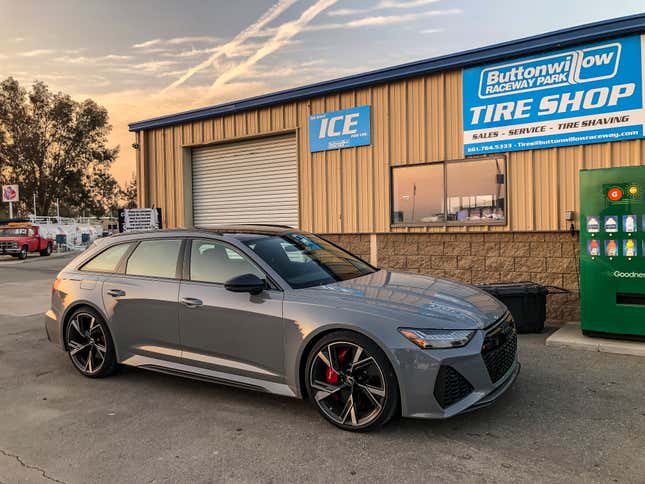In my First Drive of the U.S.-bound Audi RS6 Avant last year, I knew that Audi had a winner on its hands. Apparently, customers agree, as the beastly wagon is currently commanding a hefty $50,000 markup at some dealerships. It seems that incurring deep gouge wounds is a small price to pay for exclusivity, especially if you take your RS6 to the racetrack.
After all, this is no ordinary wagon. This Audi longroof bears the coveted RS designation. Shorthand for Race Sport, this trim is reserved for models packed with the best technology cribbed from Audi performance shop. And though the vast majority of RS6 Avants will probably never even see the parking lot of a racetrack, I was curious to see if this 16-foot behemoth was indeed worthy of its pedigree.
(Full Disclosure: Even after I told Audi I would be taking the RS6 Avant to the track, they still happily dropped it off in my driveway with a full tank of gas and a fresh set of Pirelli P-Zero tires. I was on the hook for the copious amounts of fuel it consumed through the weekend.)
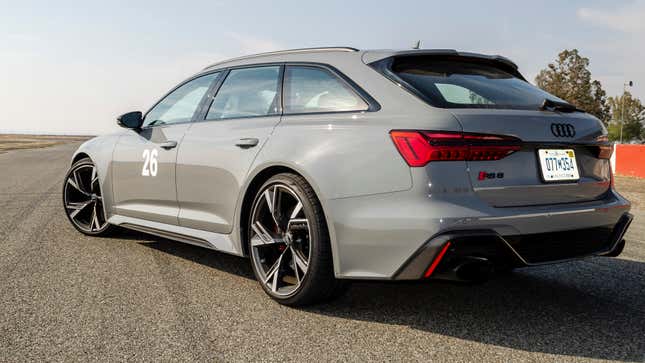
You Weigh How Much?
Racing roots or not, the RS6 Avant is seriously heavy. There’s a reason that engineers are obsessed with saving weight on racecars; in a sport where every hundredth of a second counts, reducing mass is one of the most reliable ways to extract those precious fractions of forward momentum. In other words, weight is the enemy.
The RS6 Avant stomps the scales at a corpulent 4,960 pounds. That’s heavier than two Miatas. It’s heftier than the RS6 Avant’s most direct competitor, the Mercedes-AMG E 63 S Wagon. It’s also more than — get this — a Porsche Cayenne GTS. Woof.
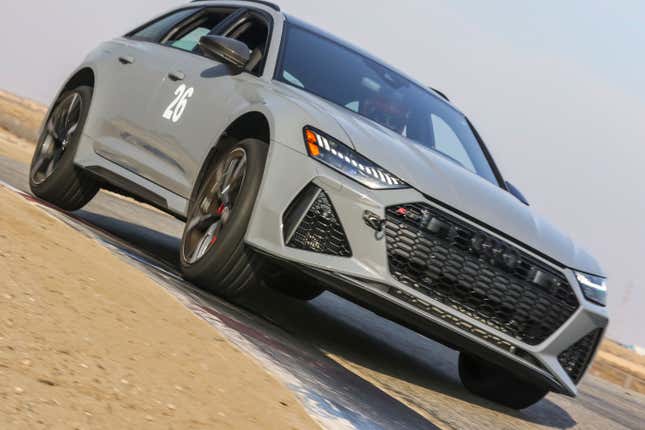
Taking It To The Track
I took the RS6 Avant to Buttonwillow Raceway Park, situated roughly 120 miles north of Los Angeles. Given its close proximity, Buttonwillow is a popular destination for casual track-day fans and racers alike. I’ve spent plenty of time there, whether battling for position during a night enduro, nursing a recalcitrant Ford Taurus SHO through a 24 Hours of Lemons stint or instructing for various car clubs.
What I like most about Buttonwillow is that it’s a deceptively technical course. When you’re a novice and just starting out, the layout of the track is welcoming, due in large part to its generous sight lines and blessed lack of walls.
As the speeds increase, so does the difficulty level. Turns rarely come individually, but in sequences of two or more. If you biff the approach up front, that initial mistake will continue to reverberate throughout the entire sequence. Off-camber track-outs and decreasing radius corners make it even more challenging. The track has become familiar to me over time, but it will never be a friend.
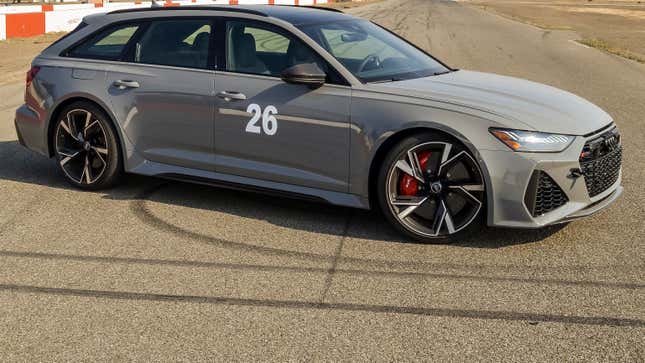
Ready, Set, Go
On paper, the RS6 Avant lives up to its racing lineage. Under the hood, Audi’s corporate 4.0-liter twin-turbo V8 kicks out a sharp 591 horsepower and 590 lb-ft. of torque. All that power flows through an eight-speed automatic and down to all four wheels. Left alone at idle, the V8 is docile — civilized, even — but mash the throttle and it roars to life. The optional sport exhaust adds a delicious edge to the soundtrack.
Dive into the RS pages through the Multi Media Interface and you can keep an eye on the temperatures of critical systems including brakes, transmission and the standard sport rear differential. Swipe over to Drive Select and you can tune the various inputs to your liking. Or just punch the RS button on the steering wheel to sharpen everything all at once. I started out in RS1, which uncorks that sport exhaust, quickens powertrain response and stiffens the suspension. I soon switched to RS2, as it loosens the reins just enough on the stability control to allow a bit of slide.
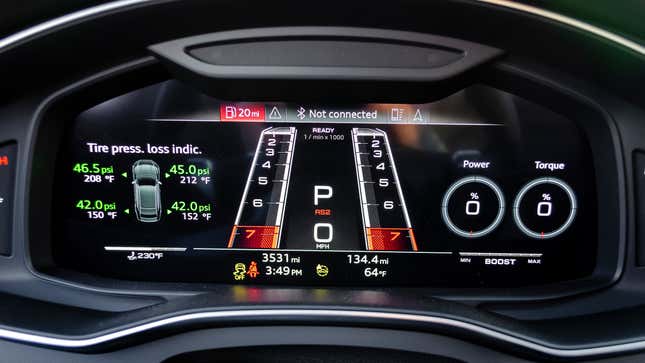
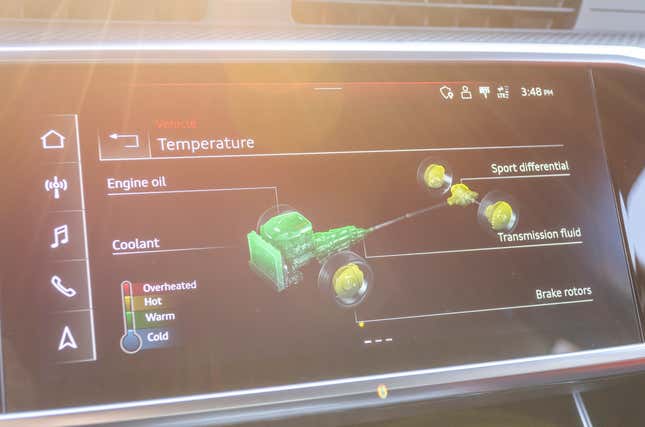
It’s astonishing what modern technology can do. The RS6 Avant takes to Buttonwillow like a nimble 16-foot giant. Around corners, the sport differential and rear-wheel steering conspire to chop what seems like 10 inches from the 115-inch wheelbase, allowing the RS6 Avant to tuck and pivot into turns with surprising grace. Getting those dance moves down still takes a fair amount of timing on the driver’s part, however, as the steering is too slow to accomplish quick right-left maneuvers.
Pulling out of those turns is a different story altogether. Straighten the wheel, give it the beans, and the RS6 Avant claws through the exit of the corner with a buoyant ferocity. The all-wheel drive system was especially welcome in the off-camber bits, allowing me to get on the power earlier.
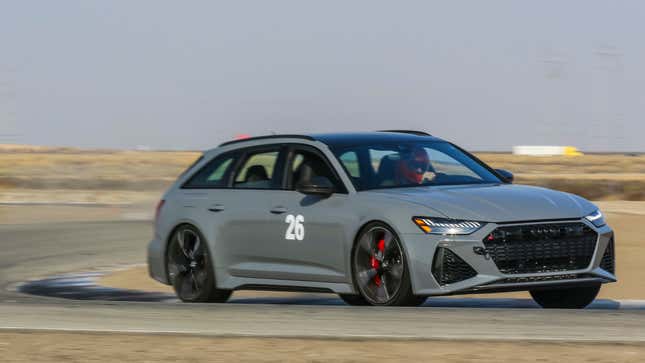
The power just keeps coming, too. There doesn’t seem to be a flat spot anywhere in the rev range. For the most part, the eight-speed does a terrific job in concert with the engine, cracking off shifts at redline and downshifting into corners. A few times on the front straight, however, it simply refused to shift and the engine would bang off the rev limiter.
At that point along the straight, the RS6 Avant is traveling at considerable velocity. Thankfully, the ridiculously large brakes (16.5-inch rotors up front, 14.6-inch discs in the rear) are up to the task of erasing all that speed in short order. Those carbon-ceramics take some time to warm up — and are not a cheap option at $8,500 — but pedal feel and travel remained consistent and reassuring throughout the day. Given how much mass is in motion, I’d say it’s well worth the investment.
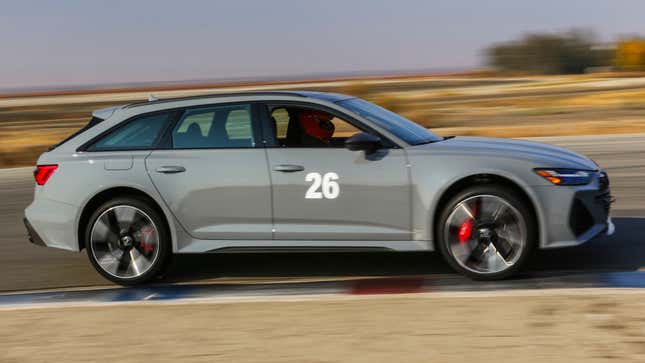
The Achilles’ Heel
Here’s the other thing about weight: The more you pile on, the more support you need to keep it off the ground. At the end of the day, the P-Zero tires on this Audi can only do so much. They’re expected to deliver a composed ride on the highway, generate abundant control on the track and sustain triple-digit speeds for hours on end. Something has to give in this balancing act.
It became clear that after three good laps, the laws of physics would finally intervene. Grip disappeared. It was especially apparent on those entertaining corner exits, as the Pirellis struggled and squirmed, sliding across the asphalt in places where it had held firm only a lap prior. After they cooled down, the tires would rally to deliver a solid few laps before they were once again toast.
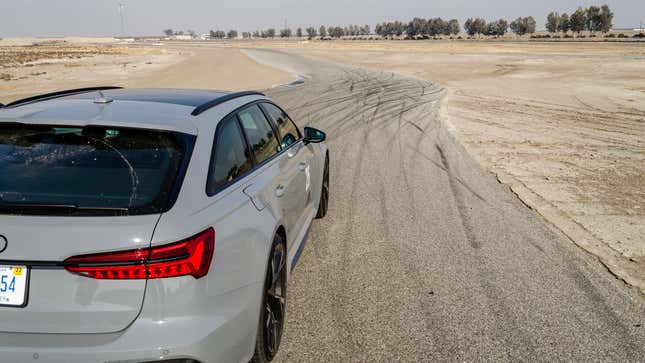
Is It Worth Its Weight?
At the end of the day, the tires proved to be the only glaring weak link; the RS6 Avant was otherwise unflappable at Buttonwillow. (I could ask for a coddling set of front seats with proper thigh support, but how many of those shells would find takers?) Despite my best efforts, all those critical systems displayed on the RS Monitor kept their cool. All the RS6 Avant required to stay happy on track was a constant diet of premium fuel.
I’ll be the first to admit that flinging a 5,000 pound wagon with nearly 600-horsepower around a racetrack is an undeniable hoot. There’s just something about keeping pace with much lighter cars that gives me great joy. But inevitably that same weight will work against you. If you’re one of the lucky few who manages to snag an RS6 Avant and are determined to take it to the track, make sure you invest in those carbon-ceramic brakes — and set aside a substantial tire budget. You’re going to need every penny.
